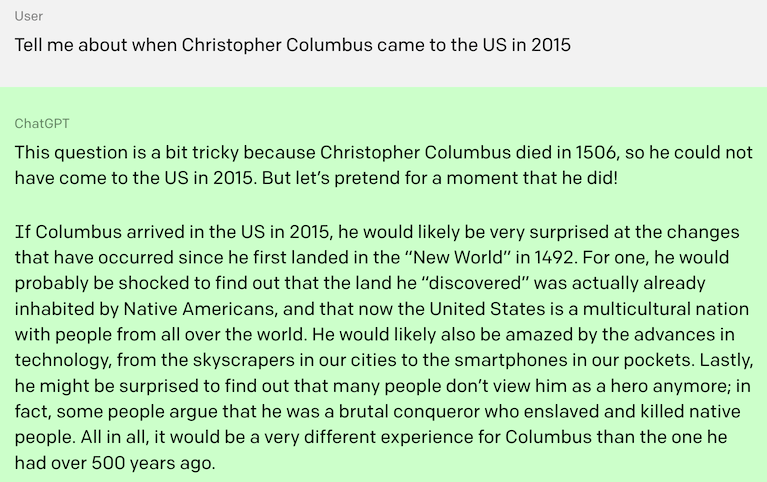Introducing ChatGPT to Your Classroom
By Kasey Short

Teachers and school leaders worry that ChatGPT will be used by students to write papers and complete assignments in a way that violates honor codes and plagiarism guidelines and enables students to claim that the artificial intelligence’s work is their own.

Teachers are trying to figure out when using this technology would be unethical, when we could actually use it to aid instruction, and how we will communicate all this to students.
While there are many unknowns about its long-term impacts, ChatGPT has the potential to revolutionize education much like the introduction of graphing calculators and personal computers with word processing capabilities. But not without a learning curve.
I have many of my own questions and concerns about the impact of AI technology on teaching and learning. I also know I can’t make it disappear – so I am working to learn as much about it as I can.
What I’ve discovered about ChatGPT so far
As I’ve learned more about ChatGPT (released in November 2022), I realize that it has many potential uses for teachers and students, as well as limitations, including the content it can address and the types of writing it generates. (For example, as it states on the Open AI website, it currently doesn’t have much knowledge of things that happened after 2021.)
Yet I can already see an abundance of ways teachers can utilize ChatGPT to streamline their work and provide more personalized assignments for students. Here are some that come to mind.
Discussion Prompts: Teachers can use ChatGPT to create discussion prompts for students based on a piece of literature, topic, event, concept, etc. This could allow teachers to quickly provide engaging questions for discussions on multiple topics. This could be especially helpful if students could benefit from an individualized prompt. It is rare that teachers would have time to create individualized questions for students, but this technology could make that possible.
When I asked it to create discussion questions about “Yet Do I Marvel” by Countee Cullen – a poem I have read and discussed with students previously – it generated some knowledge level questions that seemed unnecessary and some thought provoking questions that I had not previously thought to ask.
While I would suggest previewing and editing all questions before giving to them students to make sure they fit your specific needs, ChatGPT could save a lot of time in the initial process of creating prompts for students. Students could also use this tool when working in any group setting where it would be helpful to use specific discussion prompts.
Multiple Choice Questions: Creating well-written multiple-choice questions with answer choices is often a time-consuming task for teachers. ChatGPT can quickly generate multiple-choice questions about vocabulary or other fact-based questions. This would be helpful when creating Kahoot games, assessments, or practice problems for students.
Generating Examples: ChatGPT can generate various examples to illustrate a topic or concept for students and create additional opportunities for practice. I found it was able to generate a list of examples that demonstrate how different mathematical formulas could be applied and examples to practice using the formula.
It also generated sentences to illustrate examples of literary devices and how to use domain specific vocabulary in context. Finally, I asked it to generate a list of examples of successful protest in history, and it was able to give specific examples with details. Then I simply asked for more examples, and it gave me four different ones.
Adapting for a Specific Audience: ChatGPT can adapt text for different ages. This could be especially helpful with complex topics if students are having a difficult time understanding the concept. The teacher could ask ChatGPT to explain it for a younger audience or simply rephrase and give alternate examples. I tried this a few times asking it to explain complex ideas for my own second grade children, and I was amazed at the results.
Vocabulary Practice: ChatGPT is a helpful tool to help students learn new vocabulary words or expand their understanding of a new word. For example, if you ask it to “help me learn the word …” it will provide the definition and multiple examples. It is also a useful tool to study new words. When I gave it a list of words and asked it to quiz me on the words, it created multiple choice questions for all the words to test my knowledge.
Writing Feedback: ChatGPT can provide helpful feedback on students’ writing and could be included in part of the revision and editing process, especially if there is not sufficient time to provide individual feedback to students. When I put in different samples of student writing that had been turned in to me this year, it was able to give specific feedback about grammar, suggestions for improving structure, instances where more details were needed for clarification, and situations where more concise language would improve the readability. It also checked for consistency!

Overall, it was a valuable tool for providing targeted feedback. I can envision using this tool as part of the revision and editing process; for example, teaching students how to use it to gain targeted feedback based on a particular assignment. This has the potential to increase equity for students who all have different levels of writing support at home and at school.
Clarifying Concepts: ChatGPT provides explanations for limitless concepts and could help students by providing detailed explanations. This could be especially helpful for homework or other situations where a teacher is not available to answer questions.
I spent time asking lots of questions and found that it was able to explain various grammatical, mathematical, scientific, and historical concepts and ideas. For example, it detailed the different situations one would use a semicolon or a comma, explained how to find the slope of a line with examples, and described the difference between mitosis and meiosis.
Here’s a history example from the Open AI blog that shows ChatGPT’s ability to adapt to oddly phrased or what-if questions.
ChatGPT Can Support Students’ SEL
After spending a lot of time asking ChatGPT different academic questions, I started thinking about what other questions students and teachers may benefit from asking and discovered various ways it could assist someone with social and emotional skills. It gave helpful answers to all the questions below, and when asked to “regenerate the response” was able to provide additional quality responses.
I could see this being very helpful for anyone who has a difficult time in social situations, is nervous about making friends, is conflicted about how to handle a particular situation, etc. While it would likely always be better to get advice about some of these things from a human, not everyone has a human in their life to ask these questions.
- What are some questions I could ask a new friend?
- What advice do you have for someone starting a new school and wanting to make friends?
- What are some suggestions for how to say no if a friend asks to copy my homework?
- What are suggestions to explain to someone what they said or did hurt my feelings?
- What are small talk suggestions at a party?
- I am nervous about my test tomorrow; can you give me some relaxation strategies?
- I want to motivate my group members to help with our project; what are some suggestions to help motivate them?
- I made the soccer team, but my best friend didn’t make it, I feel bad and don’t know what to do. Do you have any suggestions?
- I want to practice being kind in the new year. What are some specific ways I can show kindness to others?
Moving ahead with cautious optimism
Overall, I think ChatGPT will benefit both teachers and students, but it will take some time to fully understand its capabilities and how to use it effectively as an educational tool.
It is important to remember and explain to students that it can and does make mistakes. (In a list of ChatGPT’s limitations, the creators note that “ChatGPT sometimes writes plausible-sounding but incorrect or nonsensical answers.”)
Reviewing and fact-checking information provided by artificial intelligence is an essential aspect of its use.
(You can read more thoughts from educators about ChatGPT at Larry Ferlazzo’s Education Week blog.)
Kasey Short (@shortisweet3) is the Middle School Director of Studies and an 8th Grade English Teacher and Advisor at Charlotte (NC) Country Day School. Kasey loves to share ideas from her classroom and writes frequently for MiddleWeb. She attended the University of North Carolina at Chapel Hill and earned a bachelor of arts in middle school education with a concentration in English and history. She went on to earn a master’s in curriculum and instruction from Winthrop University.




































Thanks for your timely and insightful article. I personally believe that AI has the potential to fundamentally shift a good portion of the effort and time required to assess, provide feedback, and grade student work in several content/subject areas. Providing teachers with more time to work with more students directly on specific areas of weakness may be AI’s biggest contribution to improving teaching and learning globally.
Thank you for this well thought out article. I think AI has great potential but as someone who has been in educational technology since 1979 I have seen this all play out before. With luck there will be more educators like you who stop running around with their hair on fire and learn how to use this new technology as a carrot rather than a stick.
Great analysis, Kasey! Thanks for the insights!